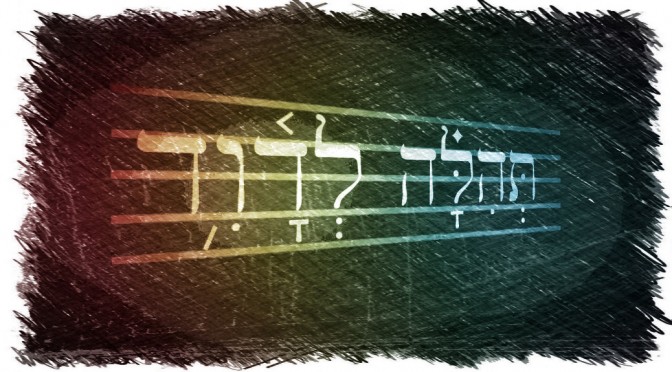
Lessons from the Psalm Inscriptions
In Leading God’s People in Prayer and Praise
Titles of Interpretation
The inscriptions included at the beginning of many of the psalms offer valuable instruction for church musicians. They provide brief glimpses of the worship practices of ancient Israel and the Temple. In earlier posts we considered four categories of titles: designation, description, explanation and application. The final category of psalm inscriptions is interpretation.
Thirteen inscriptions included in the first three books of the Psalter relate to interpretation, clarifying how the psalm was musically performed or sung. These inscriptions always follow the designation to the chief musician (lamnatstsech). Although these headings are the most difficult of the five types to satisfactorily understand and adequately translate, they include terms that most likely denote musical instrumentation, voicings, melody or tune names, and musical styles. All but one use the preposition ‘al meaning upon or according to or the proposition b meaning with.
Instrumentation
Three of the headings appear to indicate musical instrumentation. They refer to stringed instruments, flute or wind instruments, and an unknown instrument of Gath.
With Stringed Instruments
An instruction to perform with stringed instruments appears in five psalms. [1] The singular with a stringed instrument occurs in two psalms. [2]
The Hebrew inscription binginoth consists of the preposition b meaning with or on and the plural form of the noun neginoth. Neginoth comes from the root nagan meaning to touch (strings) or to play a stringed instrument. [3] Most modern versions translate the inscription as with stringed instruments or simply for strings. The KJV leaves the term untranslated as on Neginoth.
Stringed instruments were especially important for the accompaniment of the psalms in the Temple worship, as Edersheim explains:
That music was chiefly sustained by the harp (Kinnor) and the lute (Nevel). Of the latter (which was probably used for solos) not less than two nor more than six were to be in the Temple orchestra; of the former, or harp, as many as possible, but never less than nine. There were, of course, several varieties both of the Nevel and the Kinnor. The chief difference between these two kinds of instruments lay in this, that in the Nevel (lute or guitar) the strings were drawn over the sounding-board, while in the Kinnor they stood out free, as in our harps. [4]
Idelsohn adds: “These two instruments were the most important ones, without which no public religious ceremony could be held.” [5]
Upon Flutes
The inscription el-hanechiloth occurs only in Psalm 5. It consists of the preposition el meaning upon and the plural form of the noun nechilah which most likely denotes a flute. [6] Most modern versions translate the heading as for flute accompaniment or simply for flutes. As with neginoth the KJV leaves this term untranslated, upon Nehiloth.
Flutes were primarily used on special occasions and festivals in the worship of Israel, including Passover, Pentecost, and the Feast of Tabernacles. [7] According to Edersheim, “the flute was also used by the festive pilgrim-bands on their journey to Jerusalem, to accompany ‘the Psalms of Degrees,’ or rather of ‘Ascent,’ sung on such occasions.” [8] This heading does not appear on any of the Songs of Ascent, however, all of the psalms in Book V lack titles of application.
When flutes were used in the Temple, they were highlighted as solo instruments as Edersheim notes:
In the Temple, not less than two nor more than twelve flutes were allowed, and the melody was on such occasions to close with the notes of the flute alone. [9]
Upon the Gittith
The instruction ‘al-hagitith appears in three psalms. [10] The Hebrew phrase consists of the preposition upon ( ‘al), the definite article h and an uncertain term gittith.
The term gittith most likely refers to a musical instrument named after the Philistine city of Gath. [11] David spent time in Gath when he was fleeing from Saul (1 Samuel 21:10–15). He would have been aware of their musical practices. Kraus suggest, however, that the term “probably refers to a melody” and should be rendered according to the Githitic (tune). [12] The KJV, NAS, NIV, ESV and NRSV all leave the term untranslated. The NKJV has on the instrument of Gath.
Voicings
The two headings indicating a certain voicing or tuning of the stringed instruments are the first of the headings to appear in Scripture outside the Psalter. They are found in 1 Chronicles 15:20 and 21 where David prepares to bring the ark to Jerusalem and appoints Levites to oversee the worship of God.
The singers, Heman, Asaph, and Ethan, were to sound bronze cymbals; Zechariah, Aziel, Shemiramoth, Jehiel, Unni, Eliab, Maaseiah, and Benaiah were to play harps according to Alamoth; but Mattithiah, Eliphelehu, Mikneiah, Obed- edom, Jeiel, and Azaziah were to lead with lyres according to the Sheminith. Chenaniah, leader of the Levites in music, should direct the music, for he understood it (1 Chronicles 15:19–22).
The use of the inscriptions in this historical context reveals that they are ancient, going back at least to the beginning of David’s reign as king.
According to Sheminith
The heading ‘al-hasheminith occurs in Psalms 6 and 12. The term is unclear, but likely instructs the instrumentalist to tune to or play in a lower key.
The KJV, NIV, ESV and NRSV leave the term untranslated. NKJV has on an eight-stringed harp. The NAS has upon an eight-stringed lyre. Klein suggests two possible meanings: a musical instrument probably of 8 strings or an octave. [13] Peter Craigie, in his commentary, renders it upon the octave implying a lower tuning or bass accompaniment, which, he says, “would be appropriate to the solemn theme of the psalm.” [14]
According to Alamoth
A similar heading to sheminith occurs in Psalm 46, ‘al-‘alamoth. This term is also uncertain, but is likely a compliment to sheminith, especially in light of their use in 1 Chronicles 15:20–21. Alamoth, therefore, would denote a tuning to or playing in a higher key.
The KJV, NKJV, NAS, NIV, ESV and NRSV all leave the term untranslated. Klein refuses to speculate on this term saying it is “of uncertain origin and meaning.” [15]
Melodies
At least seven headings in the psalms suggest the use of pre-existing tunes or well-known melodic patterns to perform the psalm. Idelsohn explains the role of these tunes in Israel’s worship:
The vocal song of the Temple, like all religious song among the ancient and primitive nations, drew its sap from the folk song, though foreign tunes may have occasionally crept in. These Temple songs—folk-tunes modified and sanctified—were in turn copied by the ‘representatives of the people,’ the Anshe Maamad, from all parts of the country, who learned the melodies together with the texts, and would carry them to their homes. [16]
Curt Sachs further clarifies the use of these melodic patterns:
Oriental music has always been, and still is, composed in well-defined designs or melodic patterns. These melodic patterns might be compared to the three Greek orders or styles in architecture, the composition of which had detailed rules with which the artist was compelled to comply, and only within these specifications could he follow his personal interpretation. In music, melodies using the same scale, and relating to each other by their general mood, belong to one melodic pattern. [17]
According to Aijeleth Hashachar
The tune Aijeleth Hashachar is found only with Psalm 22. The KJV and NAS leave the title untranslated, but other versions have spawned a number of suggested translations. These include: The Deer of the Dawn (NKJV and NRSV), The Doe of the Morning (NIV), and Doe of the Dawn (ESV).
According to Jonath Elem Rechokim
The title ‘al-Jonath Elem Rechokim occurs only in Psalm 56. The terms in the heading are uncertain and have produced a number of various translations: The Silent Dove in Distant Lands (NKJV), A Dove on Distant Oaks (NIV), The Dove on Far Off Terebinths (NRSV and ESV). The KJV and NAS leave the title untranslated.
According to Shoshannim
The inscription ‘el-shoshannim means literally upon Lilies. Of the seven inscriptions that likely refer to tune names or melodic patterns, this one presents the most difficulty. It occurs in three psalms, 45, 69, and 80. Psalm 45 is a song of love replete with praise and adoration. Psalm 80, however, is a lament containing a refrain that pleads with God for revival. It seems improbable that two psalms of such different character could be performed with the same musical setting.
The phrase is literally translated as Lilies (NKJV, NIV, NRSV, and ESV). The KJV and NAS leave the title untranslated.
According to Shushan Eduth
The title ‘al-shushan appears only in Psalm 60. Although the term ‘eduth meaning a testimony is often included as part of the tune name, it should be considered as a separate title of description, as in the heading to Psalm 80. The title ‘al-shushan consists of the preposition according to (‘al) and the noun lily (shushan) which appears in the plural form in Psalm 45, 69, and 80. Commentators who attached ‘eduth to this title assume unnecessarily that the noun shushan is in the Construct state and must be linked with the following term. The translation of the title should read, however, to the tune “A Lily.”
The KJV, NAS and ESV leave the title untranslated. Translated tune names include: Lily of the Testimony (NKJV) and The Lily of the Covenant (NIV and NRSV).
According to Muth-labben
The heading ‘almuth labben occurs only in Psalm 9 (Psalm 10 is a continuation of this psalm and does not have its own heading.) Owen suggests that the title derives from the words ben meaning son and ‘almah meaning young woman. He translates the performance instruction as soprano voice of boys. [18] Other scholars suggest the first word in the title relates to the Hebrew root muth meaning to die. [19]
The KJV, NAS, ESV and NRSV leave the title untranslated. NKJV and NIV translate the name of the tune as Death of the Son.
According to Machalath (Leannoth)
The title of Psalm 53 uses the uncertain term machalath with the preposition according to (‘al); Psalm 88 uses both machalath le‘annoth introduced by according to (‘al). Marvin Tate says in his commentary that the phrase is “assumed to be a tune or chanting pattern to be used with the psalm.” [20] The KJV, NKJV, NAS, NIV, ESV and NRSV leave the terms untranslated, implying this possibility.
Do Not Destroy
The heading ’al-tashcheth appears in four psalms. [21] It consists of the negative particle ’al and the Hiphil (causative active) form of the verb shachath meaning to spoil, ruin, or wipe out. [22] The KJV and NAS leave the title untranslated. The NKJV, NIV, NRSV, and ESV all translate the title as Do not Destroy.
The inscription may relate to Moses’ words in Deuteronomy 9:26, or David’s words in 1 Samuel 26:9, or more likely, to the words of a song recorded in Isaiah 65:8 which begins:
Thus says the Lord:
“As the new wine is found in the cluster,
and they say, ‘Do not destroy it,
for there is a blessing in it,’
so I will do for my servants’ sake,
and not destroy them all.”
Marvin Tate explains:
The “do not destroy it” expression seems to have been a popular saying or proverb which reflected the idea of a vineyard keeper refusing to destroy grape-vines when the first clusters of grapes were bad. The vines still had the blessing of life in them and a potential for future production. Like the vines, Israel had brought forth the grapes worthy of destruction but Yahweh would not destroy Israel because she still contained a blessing (cf. Isa 28:23-28). [23]
Styles
According to Jeduthun
This heading referring to Jeduthun, one of David’s chief musicians, appears in two psalms (62 and 77). Jeduthun’s name also appears in a title of designation (with the preposition לֹ) in Psalm 39. Tate suggests that the title in Psalm 62 and 77 employing the preposition ‘al may be “referring to a tune or musical setting, according to which the psalm was to be sung.” [24] The Hebrew preposition, however, is best translated here as according to. [25] Kraus suggests the proper rendering “After the manner of Jeduthun’s music making,” [26] denoting a particular style for which Jeduthun was known.
Conclusion
Although the titles of interpretation are the most difficult to translate, they do shed some light on the use of music in worship.
First, the titles indicate a measure of thoughtfulness and planning in the preparation and performance of music. The musicians who served in the Temple were intentional in choosing what instruments were used (strings, flutes, and even an instrument of Gath) and the key or tuning of the musical setting (lower or higher). They used specific melodic patterns or tunes to accompany certain psalms. They even used the musical settings or styles of particular composers (as with Jeduthun). The titles of application serve to remind us to put thought and care into the planning of music for worship.
Second, the titles also suggest a rich crossover between the music of the Temple and the popular music of the people (sung in homes, in the fields and in other cultural settings). Temple musicians borrowed from well-known or popular settings; they included melodic patterns that were familiar to the people. This is a point worth noting. There are some who have concluded that sacred music (music used in the worship of God) should have a decidedly distinct sound or style from secular music (music used for other purposes in the world). The psalm inscriptions, however, suggest that the musical style and arrangement of sacred and secular are not so markedly separate.
In the New Testament Paul provides a paradigm for church music that encompasses a vast array of musical sounds and styles down through history and around the world. We are to sing “psalms and hymns and spiritual songs” (Ephesians 5:19, Colossians 3:16) to the glory of God. The music of the church begins with the psalms, rooted in the worship of ancient Israel. But even in the psalms we see the beginnings of the varied sounds of praise in worship. Along with popular melodic patterns accompanying some of the psalms, we see remarkably, instructions to use an instrument (or possibly a tune) from Gath. A part of the musical tradition from a city of the Philistines, one of Israel’s enemies, is selected and sanctified for use in worship.
The psalms set a musical precedent for worship that God will accomplish in fuller measure in the New Testament through the church. Throughout church history, God has added and continues to add many musical styles and sounds to His praise. As the gospel goes out in the power of God’s Spirit, conquering hearts and lives, people from each generation and from every tribe and tongue and nation add their voice to the music of the church. There is not one sound that is solely sacred, but a vast array of musical composition that God is weaving into a tapestry of praise for His glory.
Notes:
[1] Psalm 4, 6, 54, 55, 61.
[2] Psalm 67, 76.
[3] The New Brown–Driver–Briggs–Gesenius Hebrew and English Lexicon [BDB], 618.
[4] Alfred Edersheim, The Temple: Its Ministry and Services (New York: F. H. Revell, 1874; reprint, Grand Rapids, MI: William B. Eerdmans Publ. Co., 1987), 78-79.
[5] Abraham Z. Idelsohn, Jewish Music: Its Historical Development (New York: Henry Holt and Company, 1929; reprint, New York: Dover Publications, 1992), 8.
[6] John Joseph Owens, Analytical Key to the Old Testament (Grand Rapids, Mich.: Baker Book House, 1992), 3:263.
[7] Edersheim, The Temple, 79-80.
[8] Edersheim, The Temple, 80.
[9] Edersheim, The Temple, 80.
[10] Psalm 8, 81, 84.
[11] Ernest Klein, A Comprehensive Etymological Dictionary of the Hebrew Language for Readers of English. (New York, MacMillian Publishing Company, 1987), 111.
[12] Hans-Joachim Kraus, Psalm 1–59: A Commentary, trans. Hilton C. Oswald (Minneapolis, MN: Augsburg, 1988), 31.
[13] Klein, Etymological Dictionary, 666.
[14] Peter C. Craigie, Psalm 1-50, Word Biblical Commentary, eds. David A. Hubbard, et al., vol. 19 (Waco, TX: Word Books, 1983), 90.
[15] Klein, Etymological Dictionary, 473.
[16] Idelsohn, Jewish Music, 20.
[17] Curt Sachs, The History of Musical Instruments (New York: W. W. Norton and Co., 1940), 126.
[18] Owen, Analytical Key to the Old Testament, 3:269.
[19] Klein, Etymological Dictionary, 327.
[20] Marvin E. Tate, Psalm 51-100, Word Biblical Commentary, eds. David A. Hubbard, et al., vol. 20 (Dallas, Texas: Word Books, 1990), 394.
[21] Psalm 57, 58, 59, 75.
[22] William L. Holladay, A Concise Hebrew and Aramaic Lexicon of the Old Testament (Grand Rapids, MI: William B. Eerdmans Publ. Co., 1988), 366.
[23] Tate, Psalm 51-100, 77.
[24] Tate, Psalm 51-100, 120.
[25] Tate, Psalm 51-100, 120.
[26] Kraus, Psalms 1-59: A Commentary, 30. See also BDB, 393.
This series is based on a seminar paper for “Special Research in Church Music” at Southwestern Baptist Theological Seminary (May 1995).
See a Table of Contents (thus far) for this series: Lessons from the Psalm Inscriptions
(Scripture quotations are from the Holy Bible, English Standard Version (ESV) ©2001 by Crossway)











